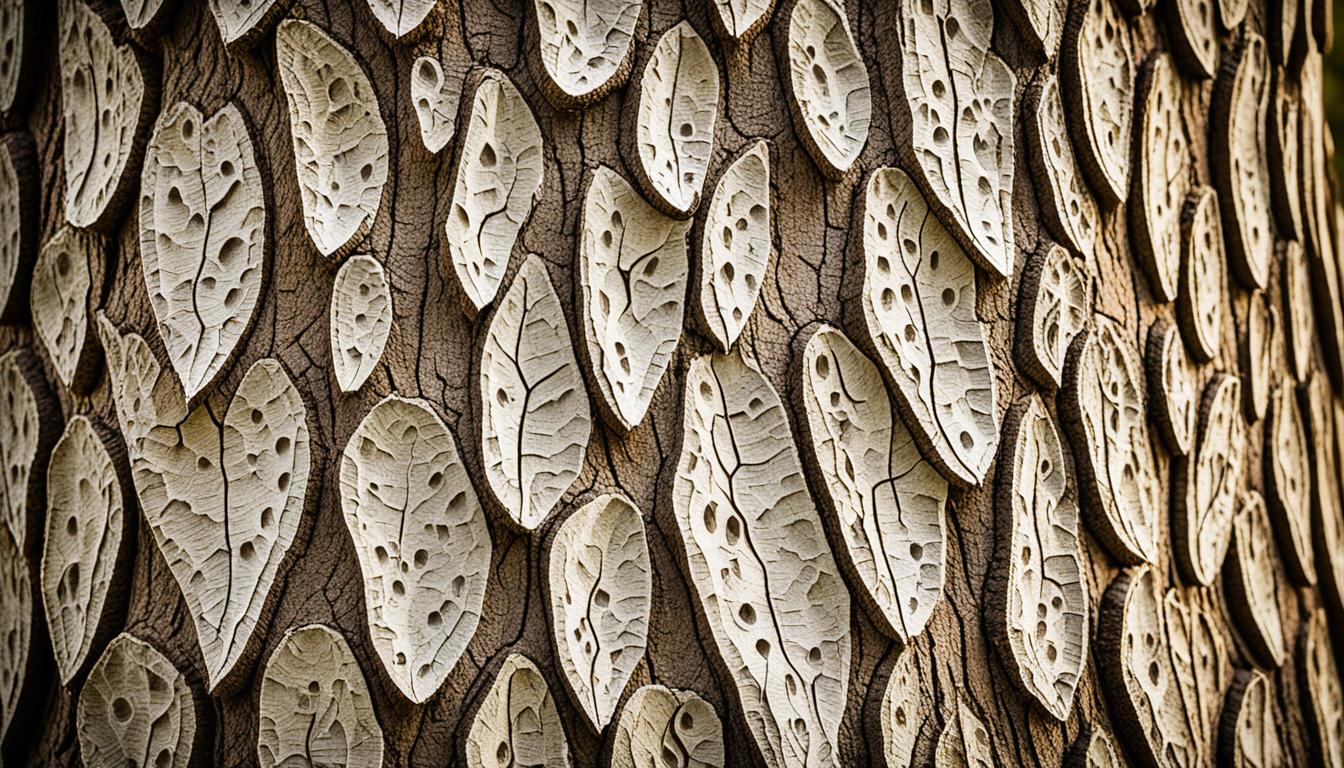Have you heard of the African Milk Tree? It’s also called Euphorbia trigona. This plant can grow up to 9 feet tall. It comes from Central Africa and is more than just a plant. It looks amazing, is easy to take care of, and cleans the air. This makes it perfect for people living in apartments. If you want a plant that adds exotic beauty to your home, this guide tells you how to do it.
Key Takeaways:
- Euphorbia trigona, also known as the African Milk Tree, is a unique succulent native to Central Africa.
- African Milk Trees are popular among apartment dwellers for their striking appearance and minimal care requirements.
- Proper care for African Milk Trees includes choosing the right pot and soil, providing adequate light, watering correctly, and monitoring for pests and diseases.
- These plants can reach heights of up to 9 feet in outdoor settings, but typically grow to about half that height indoors.
- Preventing and treating pests and diseases, such as mealybugs and spider mites, is an important aspect of caring for African Milk Trees.
Why Do We Love the African Milk Tree For Apartments?
People who live in apartments love African Milk Trees. They are beautiful and unique. These plants, also known as Euphorbia trigona, have tall, skinny stems. They have many branches and leaves shaped like teardrops.
These plants are great for apartment life because they are easy to care for. They don’t need much attention, perfect for busy people or beginners. They can survive without water for a while.
The African Milk Tree cleans the air too. It takes in bad stuff like formaldehyde and benzene. This helps make the air healthier to breathe.
Another good thing is they are safe for pets. They are not poisonous to cats and dogs. So pet owners can bring these plants home without worry.
Also, African Milk Trees are just the right size for apartments. They can grow big outside, up to 9 feet tall. But inside, they stay smaller and fit well in small spaces.

| Benefits of African Milk Trees for Apartments: |
|---|
| Unique and attractive appearance |
| Low-maintenance and drought-tolerant |
| Air-purifying properties |
| Pet-friendly |
| Compact size |
How to Grow a African Milk Tree – Learn to Grow this Indoor Beauty
Choosing the Right Pot and Soil
To grow a healthy African Milk Tree, start with the right pot. Make sure it drains well. For soil, mix cactus soil and perlite. This helps water and air move freely.
Providing Adequate Light
African Milk Trees love bright, indirect sunlight. Put them near a window that faces south. But direct sun for too long can hurt their leaves.
Watering and Humidity
Water your African Milk Tree the right way. Let the soil dry before watering again. Check the soil and water as needed.
Nutrition and Fertilization
African Milk Trees need food to grow well. Use a balanced fertilizer in spring and summer. Half-strength is best to avoid too much fertilizer.
Pruning and Maintenance
Keep your African Milk Tree looking great with regular pruning. Cut off any bad branches. Clean the leaves to keep them dust-free.
Propagation
You can grow more African Milk Trees from stem cuttings. Let the cutting dry for a few days. Then, plant it in good soil and take care of it.
Monitoring for Pests and Diseases
Keep an eye out for bugs and sickness. Look for mealybugs and spider mites. If you spot them, act fast to stop them.
Appearance of African Milk Tree
The African Milk Tree, or Euphorbia trigona, is very unique looking. People sometimes call it the candelabra cactus. It looks like a candelabra.
It has three-sided stems with sharp ridges. These ridges have thorns. The stems have teardrop leaves. This makes it look special.
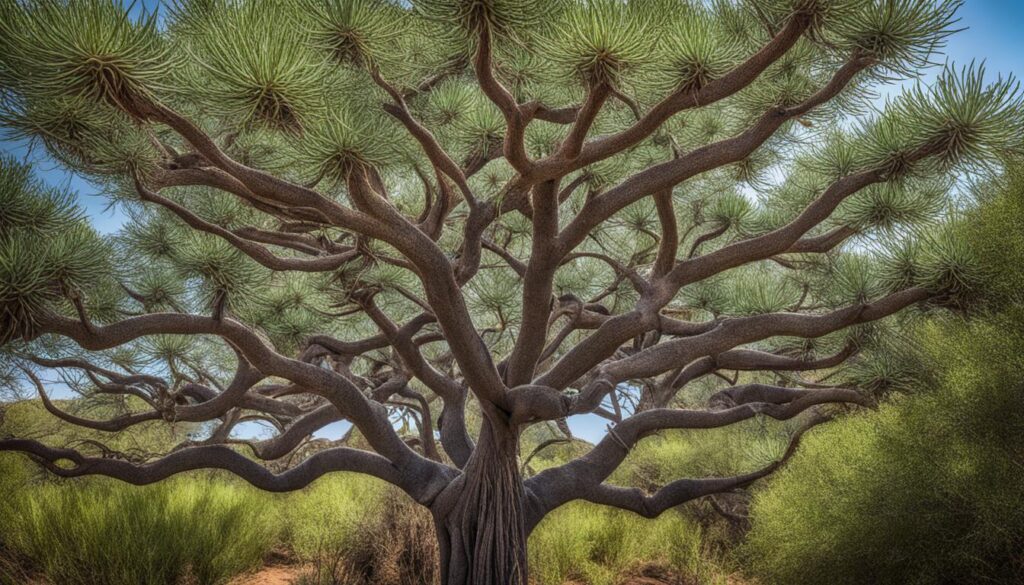
Light Requirements for African Milk Tree
African Milk Trees need bright indirect light. This light helps them grow healthy and strong. It is best to place them where they get indirect sunlight all day.
A good spot for your African Milk Tree is near a south-facing window. This window gives them filtered light, which is just right. Filtered light is similar to the light they would get in the wild.
Filtered light is sunlight that has been softened. It could pass through curtains or frosted glass. This kind of light is not too strong. It keeps the plant’s leaves and stems safe from harm.

Don’t put African Milk Trees in direct sunlight for a long time. Direct sunlight can hurt their leaves. Try to keep your plant out of the sun during the hot afternoon.
With the correct amount of bright indirect light, your African Milk Tree will do well. This makes sure it grows well inside your home.
Watering Requirements of the African Milk Tree
Watering right helps African Milk Trees thrive. These plants don’t need much water to stay healthy.
Signs of Overwatering vs. Underwatering
Watering your African Milk Tree just right is key. Too much or too little water can harm it. Below are hints to help you.
Signs of Overwatering:
- Yellowing or browning of leaves
- Soggy soil
- A foul odor
Signs of Underwatering:
- Dry soil
- Wilting
- Shriveled leaves
Check the soil’s wetness to see if water is needed. Dry soil means it’s watering time.

| Watering Frequency | Soil Moisture | Signs of Proper Watering |
|---|---|---|
| Every 10-14 days | Slightly dry | Healthy, vibrant leaves |
It’s best to water these plants less rather than too much. They store water in their stems. This way, they keep healthy for a long time.
Fertilizing a African Milk Tree
African Milk Trees need food in spring and summer. Fertilizing gives them important nutrients for growth and health. But, you must use the right fertilizer the right way. This stops too much fertilization.
Recommended Fertilizer for a African Milk Tree
Choose a balanced fertilizer for an African Milk Tree. Use a special water-soluble one for cacti and succulents. Look for a mix with NPK numbers like 10-10-10 or 20-20-20.
Always make the fertilizer weaker than the box says. Half strength is best. This stops the plant from getting hurt by too much food. Follow the box for how to do this.
Feed your African Milk Tree every 2 to 4 weeks in the growth season. Put the weak food in the soil at the plant’s base. Be careful not to get food on the leaves. This way, the roots get the food and help the plant grow well.
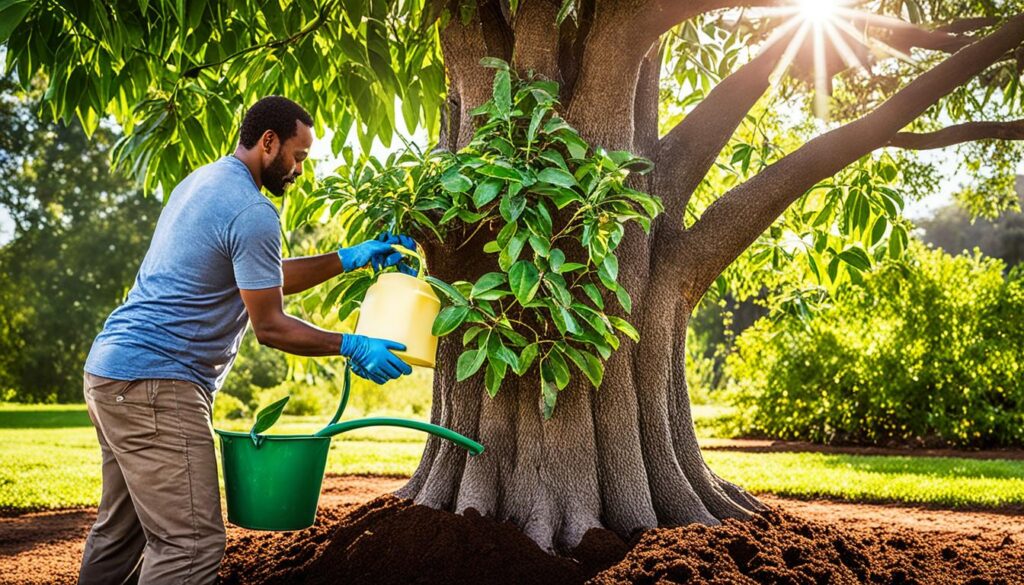
Potting a African Milk Tree
It’s important to pot African Milk Trees right. The right pot and mix help the plant grow. They also make sure the roots have enough room. This prevents the soil from getting too hard. Here is how to pot your African Milk Tree:
Choosing the Right Pot Size
Think about the plant’s roots when picking a pot. The pot should be a bit bigger than the roots. This gives them space to grow. But a pot too big can cause too much water. Make sure the pot has holes to drain water.
Using the Right Potting Mix for a African Milk Tree
A good potting mix is key for your plant’s health. Use a mix made for succulents. It helps the soil drain well and gives air to the roots. This mix has things like perlite or sand in it. This helps stop the roots from getting too wet.
Repotting When Necessary
Repot when your plant gets too big or the soil is too tight. You might need to repot if the roots fill the pot or the plant stops growing. Take the plant out gently, loosen the roots, and put it in a new pot. Be careful with the roots.
To help your African Milk Tree thrive, pick the right pot, use a good mix, and repot when needed.
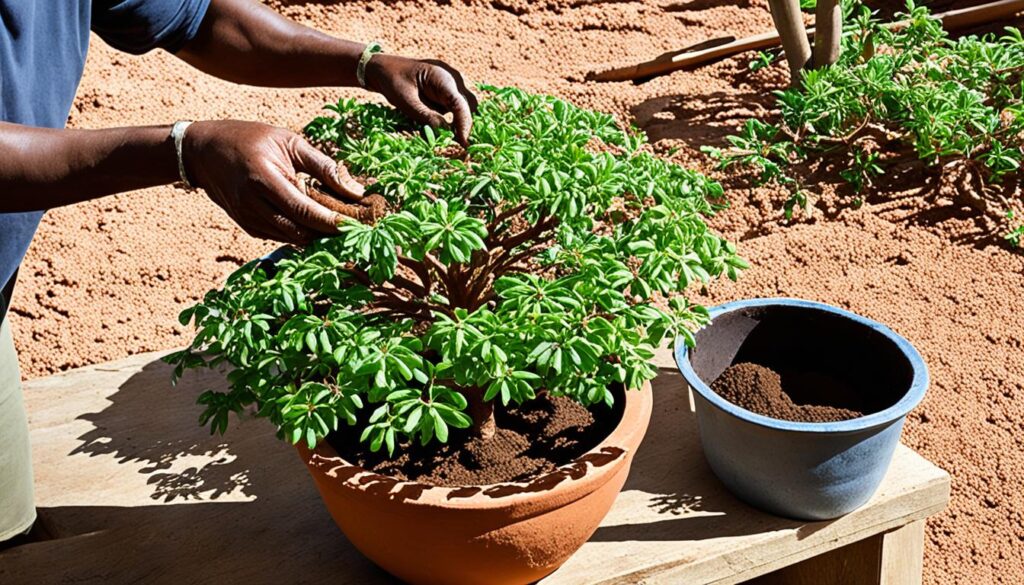
Propagating a African Milk Tree
You can grow African Milk Trees in two ways. Use stem cuttings or split the plant.
Stem Cuttings Or Seeds?
Stem cuttings are a popular way to grow them. First, choose a healthy stem. Cut it below a joint. Let the cut part dry for a few days. Then, plant it in soil that drains well. Keep the soil a bit wet until roots form.
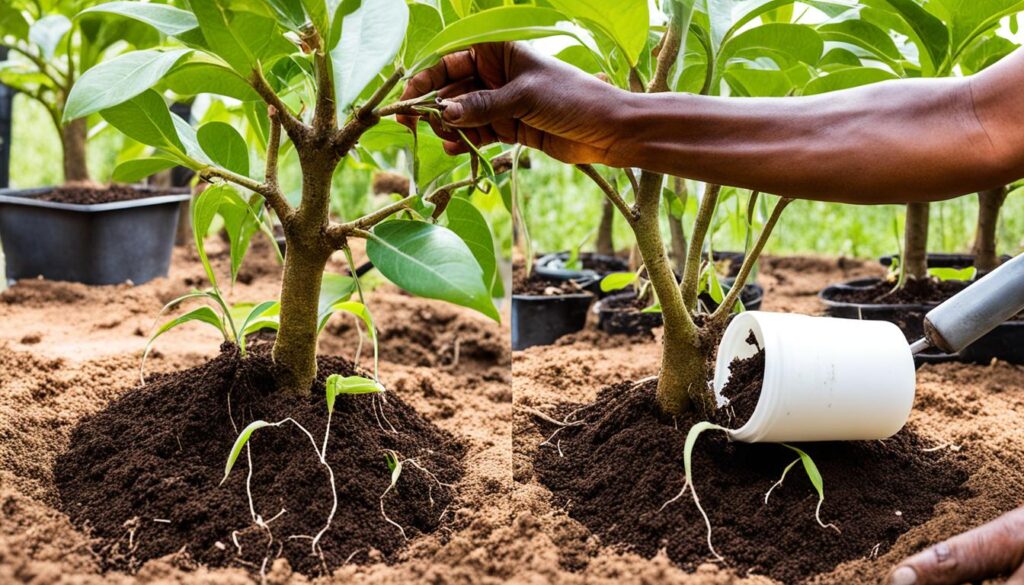
Seeds are another way, but they’re hard to find. They also take a long time to grow. So, most people prefer using stem cuttings.
Division Of A African Milk Tree
Splitting the plant is another good way to get more. This means taking the small plants growing off the main one. Make sure these small plants have roots. Then, put them in new pots with the right soil. Treat them just like full-grown plants.
Both splitting the plant and stem cuttings work well. They help you get more African Milk Trees.
Growth and Development of the African Milk Tree
African Milk Trees grow tall outside. In the wild, they can reach up to 9 feet. Inside, they usually grow half that size. Some grow slow, and some grow fast if conditions are right.
Light, water, food, and care help them grow. They need bright indirect light to stay healthy. A south-facing window is perfect for them.
They don’t like too much water. Let the soil dry before watering again. This keeps their roots healthy.
They need food in spring and summer. Use a half-strength fertilizer for them. It gives them what they need to grow.
Pruning keeps them looking nice. Get rid of bad parts to help them stay healthy.
With the right care, these trees can grow well inside. They turn into a pretty part of your home.

Dealing with Pests and Diseases in the African Milk Tree
African Milk Trees are tough against pests and diseases. But we must watch out for mealybugs and spider mites. Mealybugs look like white, cottony spots on stems and leaves. Spider mites damage leaves with webbing.
Check your African Milk Tree often for pests. If you find any, act fast to stop more harm.
Stopping pests starts with care and cleanliness. Here are ways to keep bugs away:
- Keep your plant clean by wiping the leaves regularly with a damp cloth.
- Water the right way to keep pests uninterested.
- Make sure your plant gets enough air to avoid bugs.
- Check new plants for bugs before bringing them inside.
If bugs show up, it’s time for action. Use safe sprays like insecticidal soap or oil. But remember to use them as told and not too much.
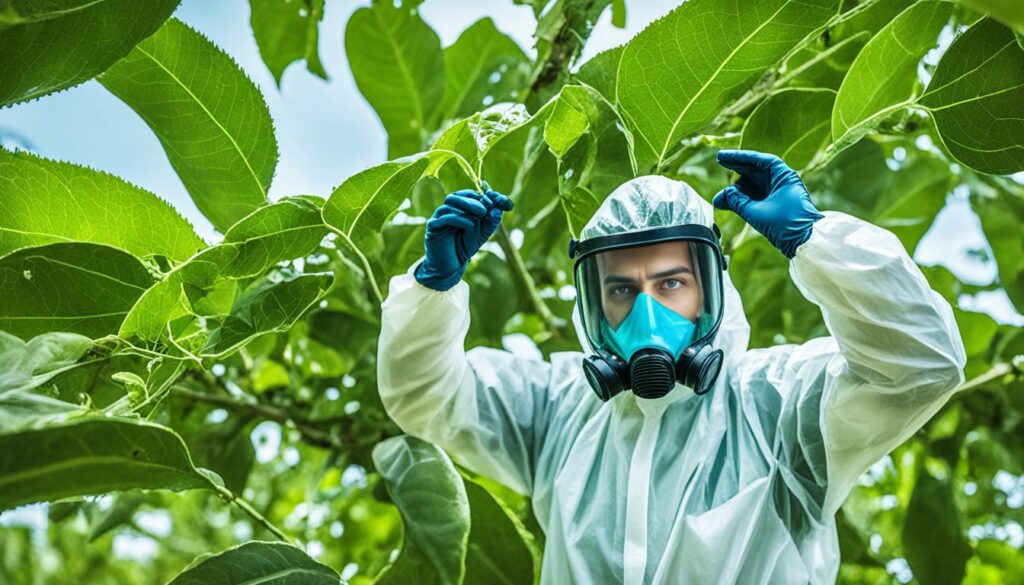
| Common Pests and Diseases of African Milk Tree | |
|---|---|
| Pest | Treatment |
| Mealybugs | Wipe affected areas with a cotton swab dipped in alcohol or use an insecticidal soap. |
| Spider mites | Use a hose to spray the plant with water to dislodge mites, or apply insecticidal soap or neem oil. |
| Leaf spot diseases | Remove affected leaves and improve air circulation around the plant. |
| Root rot | Allow the soil to dry out between waterings and ensure proper drainage. |
Common African Milk Tree Pests
African Milk Trees can sometimes get pests. These pests include mealybugs and spider mites. It’s key to watch out for them. This helps keep your African Milk Tree healthy.
Mealybugs
Mealybugs are small, white bugs that stick together on stems and leaves. They harm the tree by sucking its sap. This can make the tree grow slowly and leaves turn yellow. Check your plant often for any white, fuzzy insects. If you see them, remove them or use rubbing alcohol. Keeping your plant area clean is important to stop mealybugs.
Spider Mites
Spider mites are tiny and can harm African Milk Trees. They show up more in dry places. These pests eat the plant’s sap. They also create webbing on the leaves. You might see yellow, curling leaves. To deal with spider mites, look for webbing. Use water spray or insect soap to get rid of them. Keeping the plant in the right humidity can prevent them.
Prevention and Control
To keep pests away, care for your African Milk Tree well. Make sure it has the right light and moisture. This stops pests like mealybugs and spider mites. Also, check the plant regularly for pests. Removing pests or using water can help. If pests don’t go away, you might need stronger pest control.
Natural Predators
Handling pests on African Milk Trees can be natural. Use ladybugs or lacewings to fight mealybugs. These good bugs eat the bad ones, keeping them from taking over. Ladybugs are great against aphids, mealybugs, and scales. Lacewings munch on pests like aphids, mites, and whiteflies too.
If the pest problem is big, you might need to isolate sick plants. This stops the bugs from moving to other plants. Keep the sick plant away or use a barrier that bugs can’t get through. This lets you take care of the plant without harming others.
Sometimes, natural ways and isolation are not enough. Then, chemical pest fighters might be needed for African Milk Trees. Soap and oil sprays are two options to think about.
Disease Prevention For African Milk Trees
Keeping African Milk Trees healthy is very important. If you take good care of them and keep things clean, they won’t get sick. Here’s how to keep them disease-free:
1. Proper Care: Your tree needs the right care to stay away from diseases. This means:
- They need plenty of light but not direct sun. A window that gets a lot of light is perfect.
- Don’t water too much. Wait until the top soil is dry.
- They like air to move around them. This keeps mold and fungi away.
2. Sanitation: A clean tree is a healthy tree. Do this:
- Look at your tree often. Yellow or sad leaves mean something’s wrong.
- Take off dead leaves. They can bring bugs and disease.
- Use a wet cloth to clean the leaves sometimes.
3. Pest Control: Bugs can make your tree sick. Keep them away like this:
- Check for bugs like mealybugs and spider mites.
- If you find bugs, use safe bug killers. Always follow the directions.
Tip: A happy, well-looked-after tree won’t get sick. Stick to these tips for a strong, healthy tree.
Take care of your African Milk Tree every day. Keeping it clean and safe from bugs will help it stay healthy and beautiful.
Tips for Maintaining African Milk Trees
Wiping Leaves
It’s good to wipe your African Milk Tree leaves to keep them healthy. Dust stops them from making food with sunlight. Use a damp cloth to clean the leaves. This keeps your tree looking great.
Outdoor Exposure
African Milk Trees do well outside but need care. They don’t like too much sun or very cold weather. If they’re outside, pick a shady spot that’s safe from bad weather. Also, make sure it’s not too cold or too hot for them.
Adjusting Watering Schedule
Watering your tree right is very important. How much water it needs changes with the weather and seasons. Water it more when it’s warm and growing. Water less when it’s cold or not growing. Always check the soil to see if it’s dry or wet. Then, water your tree just right.
| Maintenance Tips | Description |
|---|---|
| Wiping Leaves | Regularly wipe the leaves with a damp cloth to remove dirt and dust. |
| Outdoor Exposure | Be cautious when placing the African Milk Tree outdoors, protecting it from extreme temperatures and direct sunlight. |
| Adjusting Watering Schedule | Monitor the soil moisture levels and adjust the watering schedule according to the plant’s needs and the season. |
Tips for Successful Overwintering of African Milk Tree
Overwintering African Milk Trees means taking special care when it’s cold. These plants can’t handle cold well. They need a warm place if it’s below 50 degrees Fahrenheit. Make sure they get enough light. Also, water them less since they don’t grow much now. Keep them away from cold winds or quick temperature changes.
To keep African Milk Trees happy, they need the right temperature. They like it between 60-75 degrees Fahrenheit. Keep the temperature steady and warm. Don’t put them where it gets very cold or drafty.
During winter, light is very important. Put your African Milk Tree where it can get bright, indirect light every day. A south-facing window works well. If there’s not enough sunlight, use a grow light to help them.
In winter, you won’t need to water your plant as much. Wait for the soil’s top inch to dry before watering again. But, don’t let the soil get totally dry. The plant could get stressed. Use soil that drains well so the roots aren’t too wet.
Keep your African Milk Tree away from places that get suddenly hot or cold. Don’t put it near cold windows or right by heaters. These sudden changes can hurt your plant. Use a humidifier or pebble tray to keep the air moist. This helps, especially when indoor heating makes the air dry.
If you follow these overwintering tips, your African Milk Tree will stay healthy and happy during the winter.
Growing African Milk Tree from Seed
Propagating African Milk Trees from seeds is hard. The seeds are rare and germinate slowly.
To grow them from seed, you need the right conditions. These include warm temperatures and moisture.
- Warm temperature: The seeds need a consistently warm temperature range of 75-85 degrees Fahrenheit (24-29 degrees Celsius) to germinate effectively.
- Moisture: The seeds should be kept consistently moist, but not soaked, during the germination process. It’s important to avoid overwatering, as excessive moisture can lead to fungal issues.
- Well-draining soil: African Milk Tree seeds should be planted in a well-draining soil mix specifically designed for succulents or cacti.
- Light: While the seeds require light to germinate, direct sunlight should be avoided, as it can cause excessive heat and potential damage.
Germinating African Milk Tree seeds takes weeks or months. Success is not guaranteed. So, using stem cuttings or division is better and more reliable.
Varieties of African Milk Tree
There is a special type of African Milk Tree. It’s called Euphorbia trigona f. rubra or ‘Royal Red.’ This tree has beautiful maroon or vivid red leaves. It really stands out in any indoor garden.
The Royal Red looks like the standard African Milk Tree but is more striking. Its deep red leaves make any room look stunning. It’s perfect for a sunny spot or as a main attraction.
Different types of African Milk Trees show off various colors and shapes. The Royal Red is an exciting choice for those who love plants. It adds bold color to your plant collection or indoor garden.

